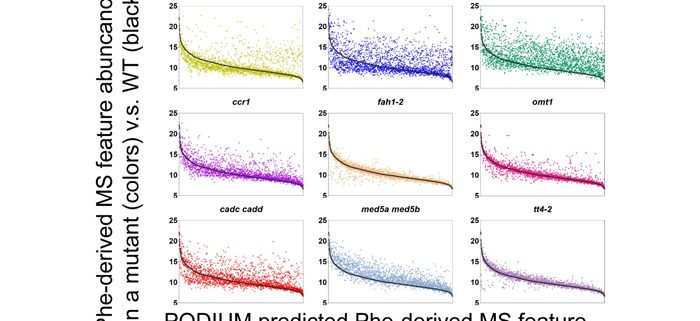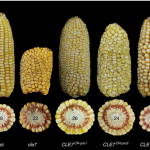Labeling the Arabidopsis soluble “Phenylalanome”
By Jeffrey Simpson, Brian Dilkes, Clint Chapple
Background: Plants synthesize hundreds to thousands of different chemicals. These chemicals help plants adapt to the biotic and abiotic factors encountered in natural environments. Through mass spectrometry (MS), we can detect and measure the abundances of many chemicals simultaneously but identifying them and the pathways from which they originate is more challenging. An improved understanding of plant metabolites’ biochemical origins would accelerate their identification and the genes associated with their biosynthesis.
Question: Many plant biochemical pathways have been elucidated by tracking the incorporation of radioactive and isotopically labeled precursors. Previous labeling studies utilized these approaches to characterize metabolic flux into one or a few target metabolites, even though many other, possibly unknown, metabolites in the pathway would have incorporated the label. In this study, we developed an easy-to-use computational tool (called PODIUM) to locate all the compounds that incorporated 13C-labeled metabolic precursors in these types of experiments.
Findings: We developed an isotopic labeling approach that established a library of metabolites produced from the amino acid phenylalanine in Arabidopsis stems. By varying genotype, using both of loss-of-function mutants and natural variants, we enhanced our understanding of how soluble phenylpropanoids are affected by mutations in genes encoding steps in these metabolic pathways. In addition, we identified phenylalanine-derived MS features that associate with natural polymorphisms that contribute to plant chemical diversity in the wild. This process located several new gene candidates affecting soluble phenylpropanoids and identified novel phenylalanine-derived metabolites to be structurally elucidated.
Next steps: We encourage other groups to use these resources to annotate metabolites in other untargeted MS datasets and to query Phe-derived metabolites associated with their genes of interest. We are also currently expanding the use of this pipeline to catalogue metabolites derived from any precursor and from any species with analogous genetic resources.
Jeffrey P Simpson, Cole Wunderlich, Xu Li, Elizabeth Svedin, Brian Dilkes, Clint Chapple. (2021). Metabolic source isotopic pair labeling and genome-wide association are complementary tools for the identification of metabolite–gene associations in plants. Plant Cell. https://doi.org/10.1093/plcell/koaa046.




